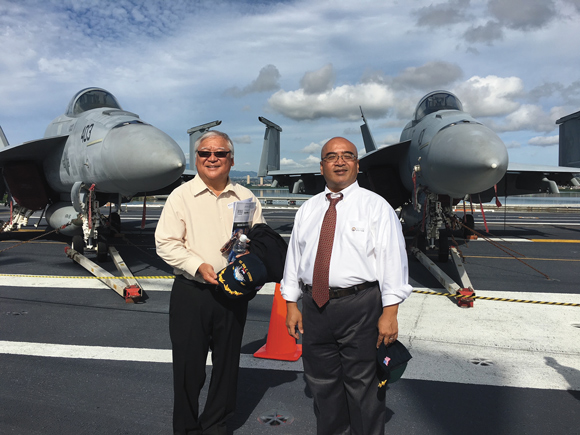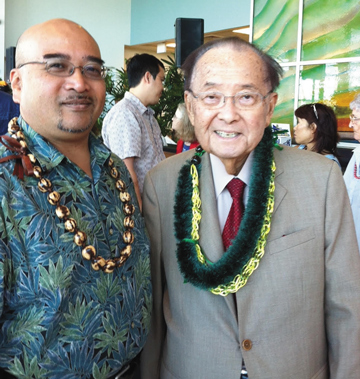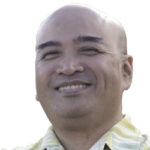
Our US Military on Maui
Gilbert S.C. Keith-Agaran
Growing up on Maui, the military was something in Honolulu or on TV or the movies. I had relatives in the armed forces and a number of my dad’s HC&S buddies and cousins were weekend warriors with the local National Guard unit. So it was somewhat outside my experience small kid time to watch films like Tora Tora Tora or From Here to Eternity that depicted a Honolulu with the military so actively entwined with island business and government leaders. I knew about the role of Pearl Harbor in American history and the important contributions of the Hawai‘i men who served in World War II, including 442nd Regimental Combat Team Nisei Veterans like U.S. Senators Daniel K. Inouye and Spark Matsunaga. (Not until I started practicing law did I become aware of the First Filipino Infantry where future Supreme Court Chief Justice William Richardson, future Supreme Court Associate Justice Benjamin Menor and future Vice Speaker of the House Emilio Alcon, amongst others, served.) But even when I worked for Governor Ben Cayetano, I had few interactions with the Army or Navy brass except for the base closure process at Barbers Point.
But over the last 150 years, Hawai‘i and the United States military have shared strong historical connections marked by significant events. While a lot of Hawai‘i and Maui men (and now women) continue to serve in the U.S. military, local patriotism is often strained by historical missteps. To start, American marines coming ashore to protect American property and citizens secured the revolution against Queen Lili‘uokalani. The Massie trial arose from the revenge killing of uncharged and untried local youths by a socialite and her Navy son-in-law and his sailor buddies.

After annexation and rapidly after the attack on Pearl Harbor, the federal government established American military bases and installations throughout the islands. You had Pearl Harbor, Hickam Field, and Schofield Barracks on O‘ahu. Maui featured Naval Air Station Kahului (NASKA) and Naval Air Station Pu‘unēnē (the original Maui Airport). At the height of World War II, NAS Pu‘unēnē was the largest air base in the Pacific—large enough to accommodate carrier air groups—and remnants of the buildings making up the base can still be seen when driving along Veterans Highway (formerly Mokulele or Airport Highway) in the Mahi Pono fields.
During World War II, the 4th Marine Division, perhaps almost 18,000 troops, trained and lived at Camp Maui along Kokomo Road in Ha‘ikū. Maui reportedly became the largest training area for naval air groups. The military staged amphibious landing assaults along Maui’s south shore from Mā‘alaea Harbor to Mākena Landing, and practiced underwater demolitions as part of those exercises. Many areas of Maui were used as firing and training ranges.
Maui had perhaps 45,000 people in the winter of 1941 before Pearl Harbor. Towards the end of the war, over 100,000 military personnel lived on the island along with the resident population.

Photo courtesy Gil Keith-Agaran
While the military presence on the Valley Isle faded after the Japanese surrender, Hawai‘i would remain the base of operations for the last two major wars in Asia during the latter part of the twentieth century: Korea and Vietnam. While Maui’s direct interaction with the armed forces largely ended with the Japanese surrender, Maui’s young people would continue to enlist and serve.
Growing up, the major connection in real life between Maui and the military would be the continued use of its waters and Kaho‘olawe by the Navy. After getting title to the island from U.S. President Dwight D. Eisenhower in 1953, the Navy continued to bomb Kaho‘olawe as a range. A generation on the island can remember the booms during the regular exercises by the military and its international allies.
After locals began to protest the bombings, including some “illegal” occupations and landings on the island, and eventually initiated lawsuits that ultimately won victories against the Navy, U.S. President George H.W. Bush halted the bombing in the 1990s.

Photo courtesy Gil Keith-Agaran
U.S. Senator Daniel K. Inouye would pass Title X of the 1994 Department of Defense Appropriations Act, authorizing conveyance of Kaho‘olawe and its surrounding waters back to the State of Hawai‘i. Inouye in that legislation also secured $400 million for the Navy to clean up the island. By the time the funds were expended in 2004, the Kaho‘olawe Island Reserve Commission reports approximately 75 percent of the island was “surfaced cleared” of unexploded ordnance. Ten percent of the island (2,647 acres) were additionally cleared to the depth of four-feet. However, large tracts of Kaho‘olawe remains unusable due to the continued presence of unexploded ordinance. 6,692 acres were not cleared and unescorted access to these areas remain unsafe.
O‘ahu, where most of Hawai‘i’s population lives, recently had to deal with the impacts of military presence. On March 7, 2022, the U.S. Navy finally decided it would close the 1943 Red Hills underground fuel storage tank facility after initially legally filing to fight a State department of health order to end use of the tanks. Built in 1943 to hold up to 250 million gallons and located in the side of a mountain to protect them from enemy attacks, the tanks leaked fuel into the water system after an accident in the facility. While a concern for quite a while due to its location above a key aquifer providing drinking water for a major portion of O‘ahu, that leak contaminated drinking water at Pearl Harbor homes and offices. Thousands of O‘ahu residents, most of them military families and their dependents, drank the water and suffered various ailments requiring treatment. Many were evacuated to Waikīkī hotels for several weeks while the Navy flushed out its drinking water system.
The military decision appears to recognize that the old arguments for a centralized fuel storage area probably needed to change. With U.S. personnel dispersed through the Pacific, it would be better to locate fuel in various places allowing more flexibility and efficiency for Naval operations. But until the fuel tanks harmed O‘ahu residents, including the Navy’s own families, the Navy had been reluctant to change.
The State and its residents will need to face in the coming years a looming decision about the armed forces presence in the islands. After statehood, the federal government had a number of years to decide which parts of Hawai‘i’s lands it would continue to control either out-right or by long-term lease. Those leases will be ending by the end of this decade.

Gilbert S.C. Keith-Agaran practices law in Wailuku. He represents Central Maui in the State Senate. He worked at the Land Department for Governor Ben Cayetano.
